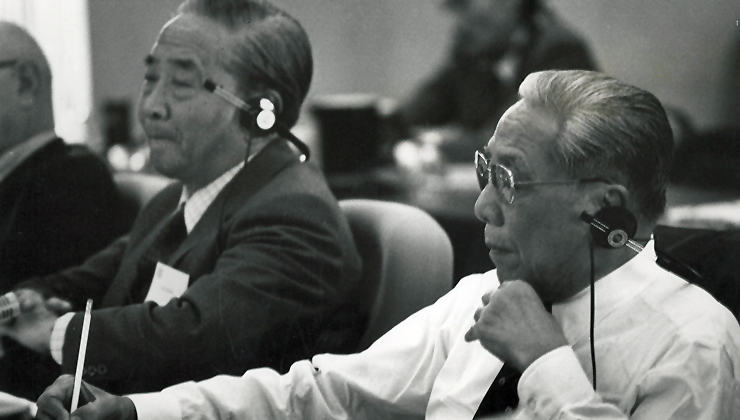Historic First
The U.S.-China Dialogue, an off-the-record gathering of leading citizens of China and America, was the first formal instance of Track II (not official government-to-government) diplomacy in the Sino-American relationship. Started in September 1984, the dialogue was held another ten times (alternating between the two countries) before coming to an end in 2002.
The dialogue had a fundamental and simple objective: to enable its participants to gain from each other’s perspective and knowledge in order to grow more comfortable with each other. The ultimate goal was to establish a foundation for achieving greater understanding and easier communication about challenges in the relationship.
The agenda for the inaugural dialogue, held at the Tarrytown Conference Center outside New York City, included the global strategic situation, the U.S.-China relationship, the international economic situation, and the problems of technology transfer. While many differing points of view were aired in the course of spirited discussions, the atmosphere at both the formal and informal sessions was warm and, by the end of the meeting, the Chinese had already invited the group to continue the dialogue in China the following fall.
Succeeding dialogues generally followed the same format: three days of discussions followed by three to five days of travel for the visiting delegation, including meetings with senior government leaders. The pre- and post-conference schedule in 1984 took the delegation to San Francisco, New York, Washington, D.C., and Los Angeles. Attesting to the importance given to both the project and the Chinese participants, the group met in Washington with, among others, Vice President George H.W. Bush, Secretaries George Schultz and Casper Weinberger, National Security Council staff director Robert McFarlane, and Senators Howard Baker, Alan Cranston, Frank Murkowski, and Ted Stevens.
The Chinese partner for this endeavor was the Chinese People’s Institute of Foreign Affairs; the Council on Foreign Relations partnered with the National Committee for the eighth and ninth dialogues, held in 1996 and 1997.
The Committee currently runs five ongoing Track II dialogues on cutting edge topics in the Sino-American relationship: Northeast Asia security issues, the nexus between the rule of law and human rights, economic issues, maritime issues and international law, energy, and healthcare. Further information on each of these can be found elsewhere on the website.
Dates of the U.S.-China Dialogues
- September 3-17, 1984 – First U.S.-China Dialogue (in U.S.)
- October 11-25, 1985 – Second U.S.-China Dialogue (in China)
- March 28-April 12, 1987 – Third U.S.-China Dialogue (in U.S.)
- February 25-March 1, 1990 – Fourth U.S.-China Dialogue (in China)
- June 12-23, 1991 – Fifth U.S.-China Dialogue (in U.S.)
- March 30-April 10, 1993 – Sixth U.S.-China Dialogue (in China)
- October 5-14, 1994 – Seventh U.S.-China Dialogue (in U.S.)
- December 1995 – U.S.-China Dialogue postponed
- June 21-30, 1996 – Eighth U.S.-China Dialogue (in China); co-sponsored by the Council on Foreign Relations
- December 10-20, 1997 – U.S.-China Dialogue (in U.S.); co-sponsored by the Council on Foreign Relations
- 1998 – U.S.-China Dialogue postponed
- June 25-29, 1999 – Mini Dialogue (in China)
- January 7-19, 2000 – Tenth U.S.-China Dialogue (in China)
- June 13-23, 2002 – Eleventh U.S.-China Dialogue (in U.S.)
